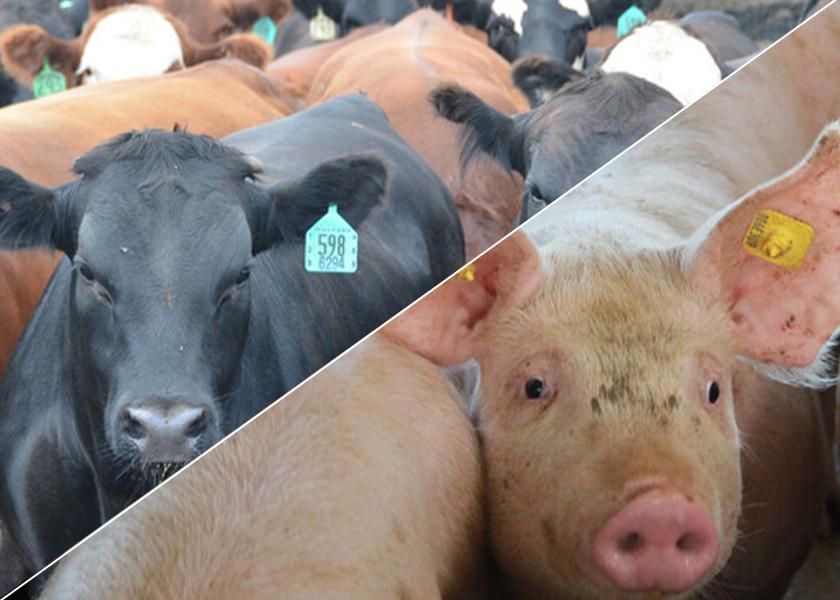Livestock Analysis | January 28, 2022

Price action: April lean hog futures rose 25 cents to $94.925, down 2.5 cents for the week.
5-day outlook: Market bulls can argue this week’s choppy, consolidative price action was actually healthy for the existing price uptrend following last week’s strong gains. Bulls need to show fresh power next week to keep the price uptrend going. Strong near-term cash market fundamentals should continue to limit the downside in futures. Pork cutout values early today slipped 15 cents to $98.04 on weakness in bellies and hams. Movement at midday was decent at 167.80 loads. The five-day rolling average national direct cash hog price today was $84.07. The latest CME lean hog index was up 55 cents to $79.75, the highest level since late October. The preliminary quote for the next index is $80.61, up 86 cents.
30-day outlook: A surging U.S. dollar may become increasingly in the coming weeks by stirring concern export demand for U.S. meat may be crimped. The U.S. dollar index reached the highest level since July 2020 today. Slaughter picked up this week after Covid-related slowdowns fostered concern over a back-up in market-ready hogs but kills still lag last year’s levels. High retail beef prices are likely to keep a near-term floor under the wholesale pork market.
90-day outlook: Spring and summer lean hog futures prices remain well below year-ago cash levels. With lower hog supplies projected in the coming months, that appears to be a bullish set-up for the hog markets into springtime.
What to do: Get current with feed advice. We are targeting a drop to the $385 area (50% retracement of the November-to-January rally) to further extend coverage. You remain hand-to-mouth on corn-for-feed needs. Our target for extending corn coverage would be a drop to the $5.75 area.
Hedgers: Carry all risk in the cash market for now.
Feed needs: You have all soymeal needs covered in the cash market through the end of January. You remain hand-to-mouth on corn-for-feed needs.
Price action: April live cattle rose $1.475 to $143.00, up 90 cents for the week. March feeder cattle rose 12 1/2 cents to $159.625, down $3.675 for the week.
5-day outlook: USDA will release its semi-annual Cattle inventory report for the U.S. after the close Monday, which may keep many traders sidelined. The report probably will reflect ongoing herd liquidation across the U.S., with significant declines in the beef cow population, number of heifers slated to join the breeding herd, 2021 calf crop and the number of younger animals destined for feedlots. Given the minimal amount of information the report typically holds concerning the short-term fed cattle outlook, it will be much more pertinent for feeder futures than those for fed cattle.
The short-term live cattle outlook doesn’t seem bullish, given an apparent backlog of market-ready cattle recently built in feedlots. However, a drop in steer dressed weights, to 922 pounds per head, marked a six-pound weekly decline and seemingly indicated some tightening of front-end supplies. This week’s preliminary slaughter total at 643,000 head came in 7,000 (1.1%) over the week prior and just 13,000 (2.0%) below the year-ago figure, showing the recent Covid-driven packing industry slowdown may be ending. Anticipation of a quick return to a full packer operational schedule, as well as rebounding wholesale quotes, may have powered today’s strong live cattle futures advance. Concurrent strength in corn and soymeal futures limited gains in feeder futures.
30-day outlook: Fed cattle supplies typically decline into February and March, which in turn plays a big part in the historical pattern of seasonal strength from early winter into early spring. Diminished late-winter supplies are typically met by surging demand as grocers and consumers gear up for the spring grilling season. If packers are truly ramping up production and demand for fed cattle, and producers consciously move cattle to get marketings current, there seems to be little reason to think the usual seasonal strength won’t emerge also, although that may mean the anticipated cash rally won’t accelerate until mid-to-late February.
90-day outlook: Spring usually translates into strength in cattle and beef prices, with country cattle quotes typically peaking sometime between late March and late April. Demand from grocers and consumers regularly continues growing through April and May, with the apex of that buying coming sometime between Memorial Day and Father’s Day, since grocers will probably have bought the bulk of their needs for Independence Day features by mid-June.
However, the supply of feedlot animals placed as light yearlings or calves during the fall start arriving at packing plants in April. That tends to increase total beef supplies, but it also drives fed cattle weights downward and decreases the percentage of choice-grade product in the beef supply (since most of those animals will only grade Select). This is part and parcel of the traditional decline in fed cattle price from early spring into summer. We expect little reason to expect a divergence from that pattern this year, although elevated retail beef prices may tend to keep a lid on fed cattle prices.
What to do: Get current with feed advice. We are targeting a drop to the $385 area (50% retracement of the November-to-January rally) to further extend coverage. You remain hand-to-mouth on corn-for-feed needs. Our target for extending corn coverage would be a drop to the $5.75 area.
Hedgers: Carry all risk in the cash market for now.
Feed needs: You have all soymeal needs covered in the cash market through the end of January. You remain hand-to-mouth on corn-for-feed needs.






